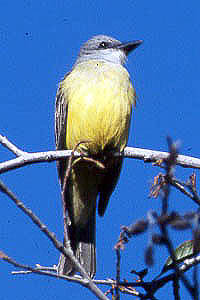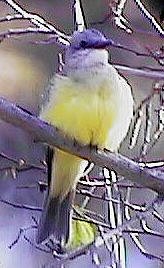Couch's Kingbird, Tyrannus couchii
Craig Park, Fullerton, Orange County, California
Tuesday 6 January 1998
Photo copyright © 1998 by Arnold Small
 Ater listening to
a message from Brian Daniels on the Northern California BirdBox that the kingbird found by James Herried on December
31st at Craig Park had been positively identified as a Couch's Kingbird, I decided to drive down to Southern California
in hopes of seeing this bird. I left the Bay Area around 6:30am and arrived at Craig Park about 1:00pm.
Ater listening to
a message from Brian Daniels on the Northern California BirdBox that the kingbird found by James Herried on December
31st at Craig Park had been positively identified as a Couch's Kingbird, I decided to drive down to Southern California
in hopes of seeing this bird. I left the Bay Area around 6:30am and arrived at Craig Park about 1:00pm.
As I entered the gate, Roy Poucher was right behind me and offered to lead me to the spot which is where a small
stream enters the northwest end of the lake. We found that several other birders were already present including
Michael Patten who had the kingbird in his scope. It was perched high in a Sycamore but it was still possible to
see the strong green coloration of the back.
I ran back to the car for my scope and met Arnold Small who was just arriving with his camera and long telephoto
lens. When I returned, the kingbird had moved downstream and was foraging in low Alder and Willow trees affording
excellent views. Then the bird started calling and soon Kimball Garrett arrived. During the next two hours I had
the bird in view most of the time and was able to study it in detail and to hear two different types of vocalizations.
The following is based on notes made shortly after seeing the bird:
Obvious kingbird, very similar in size and shape to Tropical Kingbird. In fact this bird had been originally
reported as a Tropical Kingbird. The most noticeable differences between the Couch's and a Tropical were the greener
back and somewhat shorter bill. I had seen a Tropical Kingbird in San Mateo County, several weeks earlier, so these
differences were reasonably fresh in my mind.
But the best distinction was the distinctive vocalizations which sounded like a loud, sharp "pik, pik"
often repeated. Brian Daniels had mentioned in an Internet message that it had been described as sounding like
a Downy Woodpecker, and I tend to agree. That description comes quite close. Once while chasing a nearby Cassin's
Kingbird, these loud "pik" notes were interspersed with higher, soft "seep" notes resulting
in "PIK seep, PIK seep....." This pattern with the softer notes was heard only in flight and only while
chasing the Cassin's Kingbird. Otherwise I heard only the loud "PIK" calls.
I feel that the calls are sufficient to establish the identification, but the following morphological notes
are added for the record.
The black bill was not particularly long, but was very thick and broad, with a paler brown or tan triangle on
the lower mandible, fringed with black along the edges. At close range the nostril appeared round and the rictal
bristles were dark gray or black. At very close range, the eye appeared brown with a slight reddish cast in certain
light conditions.
The face and head were gray contrasting with a strong olive-green back, rump and uppertail coverts. The lores
were noticeably darker gray, but the ear-coverts were only very slightly darker gray than the rest of the face,
and did not form an obvious mask. Someone (maybe Kimball) mentioned that in this respect the face resembled Western
Kingbird more than it did Tropical. Like most kingbirds, this one showed a crease down the middle of the crown
but I was unable to make out any color there.
I attempted to determine the wing formula, but was only able to see five visible primaries with the outermost
two almost equal in length. Michael Patten said he thought p10 was decidedly shorter than p9 so I guessed the outermost
visible ones were probably p9 and p8. These and p7 were dark without fringes. P6 and p5 were narrowly fringed paler
gray. All primary tips appeared rounded.
The wings were dark gray with narrow paler gray fringes on the tertials and coverts. The tertials and the innermost
secondary coverts appeared to me to have slightly broader fringes than the rest of the coverts although I think
Michael Patten disagreed with this assessment.
The underparts were bright yellow blending with a greenish wash across the breast. The throat was white bordered
below by a narrow gray band which contrasted with the green on the breast. The undertail coverts appeared quite
long and were a decidedly paler shade of lemon yellow than the belly.
The rectrix shafts were ivory-brown. The upperside of the tail appeared dark with very narrow light-brown fringes.
The underside of the tail appeared gray. The tip of the tail appeared notched, with the central rectrices decidedly
shorter than the lateral tail-feathers. The tips of the longest uppertail coverts were edged rusty.
The legs and toes were black with gray rectangular fringes to the scutes across the front of the legs.
While watching the bird, it ate several wasps, and once appeared to attempt to feed on an Alder tree bud. It
scratched its head once in an indirect manner lifting its foot up behind its wing. It seemed quite intolerant of
a nearby Cassin's Kingbird and chased it off repeatedly.
DISCUSSION
This is the first record of Couch's Kingbird for California. Although this bird has a somewhat limited range
and is thought to be generally nonmigratory, there are now two sight-record from New Mexico which have been verified
by recorded vocalizations. A purported specimen from Florida has been reidentified as a Tropical Kingbird.
Last January, 1997 I studied several Couch's Kingbirds near Corpus Christie, Texas where I was struck by the
intensity and saturation of the green coloration on their backs. Tropical Kingbirds also strike me as olive above,
but never have I seen one as green as the Texas birds. The Craig Park bird was also quite green on the upperparts,
although perhaps not quite as striking as the Corpus Christie birds. As usual this may be affected by light and
cloud conditions. The Texas birds were seen under overcast skies with light rain, and the Orange County bird was
seen on a bright sunny day.
I believe this bird can be aged as an immature (SY in banding terminology) by the rounded shape to the tips
of the primaries. See Pyle "Identification Guide to North American Birds, Part I", page 255.
After seeing the bird I was privileged to listen to voice recordings made by Karen Gilbert the previous day.
The bird was induced to call by playing a tape of a known Couch's Kingbird and Karen's tape includes commentary
by Jim Pike distinguishing the calls of the bird and the calls of the tape which can also be heard on the recording.
The vocalizations seem like a good match, but the tape is somewhat defective in that it has an annoying motor noise
in the background.
Additional photographs of this bird by Joel Weintraub can be viewed at  http://krypton.biomol.uci.edu/king_wcw.html.
http://krypton.biomol.uci.edu/king_wcw.html.
Photo copyright © 1998 by Joel Weintraub
--
Joseph Morlan
380 Talbot Avenue #206
Pacifica, CA 94044
 Ater listening to
a message from Brian Daniels on the Northern California BirdBox that the kingbird found by James Herried on December
31st at Craig Park had been positively identified as a Couch's Kingbird, I decided to drive down to Southern California
in hopes of seeing this bird. I left the Bay Area around 6:30am and arrived at Craig Park about 1:00pm.
Ater listening to
a message from Brian Daniels on the Northern California BirdBox that the kingbird found by James Herried on December
31st at Craig Park had been positively identified as a Couch's Kingbird, I decided to drive down to Southern California
in hopes of seeing this bird. I left the Bay Area around 6:30am and arrived at Craig Park about 1:00pm.